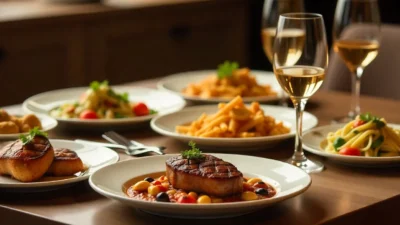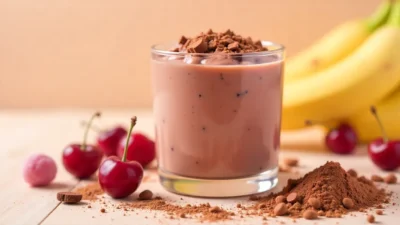Contents
- Exploring the World of Wine in Cooking: Enhancing Flavors with Every Sip 🍷👩🍳
- Signature Recipes with Wine: Elevate Every Course 🍷🍽️
- Cooking Techniques with Wine: Elevate Your Dishes with Depth and Complexity 🍷🔥
- Sauces and Reductions: Concentrated Flavor Powerhouses 🍽️🧈
- Deglazing and Braising: Building Layers of Flavor 🍖🍷
Cooking with wine is a game-changer in the kitchen, transforming everyday meals into unforgettable culinary experiences. The right wine doesn’t just add flavor—it brings depth, complexity, and an elegant touch to everything from quick weeknight dinners to sophisticated dinner parties.
When wine is used in cooking, the alcohol typically evaporates, leaving behind concentrated flavors that perfectly complement meats, seafood, vegetables, and even desserts. But which wines should you use, and how do you pair your wine-infused dishes with the perfect glass at the table?
This guide will help you navigate the world of wine and food pairings, showing you how to cook with wines you love and create harmonious dining experiences. Whether it’s a Sauvignon Blanc enhancing seafood or a bold Cabernet Sauvignon enriching a beef stew, you’ll discover the secrets to pairing like a pro.
Exploring the World of Wine in Cooking: Enhancing Flavors with Every Sip 🍷👩🍳
Cooking with wine transforms simple dishes into extraordinary culinary creations by adding depth, complexity, and unique flavor profiles. Both home cooks and professional chefs use wine to elevate meals, unlocking endless possibilities in the kitchen.
The Impact of Wine on Flavor and Aroma 🍇✨
Wine contributes remarkable complexity through its acids, sugars, and aromatic compounds. These elements interact with food to enhance natural flavors and introduce new taste dimensions.
As wine simmers, the alcohol evaporates, leaving behind concentrated flavors that permeate the dish.
- Red wines add richness and robustness, making them ideal for hearty stews and red meat sauces.
- White wines provide brightness and acidity, perfectly complementing seafood and poultry.
- The acidity in wine also helps tenderize meat proteins, resulting in more succulent and flavorful dishes.
Selecting the Right Wine for Your Dish 🍽️🍷
The golden rule of cooking with wine is simple: if you wouldn’t drink it, don’t cook with it. The quality of wine matters, as flavors become more concentrated during cooking.
Here’s a quick guide to matching wines with common dishes:
- Dry white wines (Sauvignon Blanc, Pinot Grigio): Best for seafood, chicken, and cream sauces.
- Full-bodied whites (Chardonnay): Perfect with rich fish dishes and creamy risottos.
- Light reds (Pinot Noir): Ideal for duck, mushroom dishes, and lighter stews.
- Bold reds (Cabernet Sauvignon, Merlot): Great with beef stews, lamb, and tomato-based sauces.
Avoid “cooking wines” found in grocery stores, as they often contain salt and preservatives that negatively affect flavor. Instead, choose affordable, drinkable wines that enhance your ingredients.
Also, consider the regional connection between wine and cuisine. For example, Italian wines pair beautifully with Italian dishes, creating a harmonious flavor profile developed over centuries of culinary tradition.
Wine Pairing Basics: Elevate Your Dining Experience 🍷🍽️
Mastering the art of wine pairing enhances both your food and your wine by creating harmonious or contrasting flavor combinations. The key is to match the weight and intensity of the wine with the dish for a balanced, memorable meal.
Basic Pairing Principles to Remember 🍇✨
- Match intensity: Pair light wines with delicate dishes and full-bodied wines with richer, heavier foods.
- Focus on dominant flavors: Consider the primary flavors in the dish, not just the protein. For example, a dish with a rich sauce may require a different wine than the meat alone.
- Acidic wines: Wines with high acidity cut through fatty and rich foods, cleansing the palate.
- Sweet wines: Balance out spicy dishes with a touch of sweetness for harmony.
- Tannic reds: These wines complement protein-rich foods like red meat, adding structure and depth.
Regional Pairings: Local Flavors in Perfect Harmony 🌍🍷
Regional wine and food pairings often work because they’ve evolved together over time. For instance:
- Italian Chianti pairs naturally with tomato-based pasta dishes.
- French Burgundy beautifully complements mushroom-rich meals.
Experimentation is Key 🎨🍷
While classic pairings are a great place to start, don’t be afraid to experiment and find combinations that suit your personal taste. Trying new wines with different dishes will expand your palate and enhance your dining adventures.
Signature Recipes with Wine: Elevate Every Course 🍷🍽️
Cooking with wine transforms everyday meals into extraordinary culinary experiences by infusing dishes with complex flavors and aromas. These signature recipes highlight how different wines can enhance every course—from appetizers to desserts—creating harmonious, memorable meals.
Appetizers and Starters: Light and Flavorful Beginnings 🦪🥖
- White Wine Mussels: Fresh mussels steamed in a buttery Sauvignon Blanc broth with garlic and herbs. The wine imparts crisp, bright notes that perfectly complement the seafood.
- Burgundy Mushroom Crostini: Earthy wild mushrooms sautéed in butter with a splash of red Burgundy wine, reduced to a rich topping for crusty bread.
- Champagne Shrimp Cocktail: Shrimp poached in Champagne with lemon and peppercorns, offering subtle complexity while preserving delicate flavors.
Wine Pairing Tip: Serve these appetizers with the same wine used in cooking or a similar style to create a harmonious start to your meal.
Main Courses: Rich and Robust Flavors 🍗🍚
- Coq au Vin: Classic French dish featuring chicken simmered slowly in red Burgundy with bacon, mushrooms, and pearl onions, infused with deep wine flavors.
- Risotto al Barolo: Creamy risotto made with premium Barolo wine, creating a beautiful purple hue and complex fruit notes that pair wonderfully with grilled meats.
- White Wine Lemon Salmon: Salmon fillets poached in a bright Pinot Grigio sauce with lemon, capers, and fresh dill, balancing richness with acidity.
- Red Wine Braised Short Ribs: Tender beef ribs slow-cooked in Cabernet Sauvignon for hours, developing a rich, deep flavor.
Desserts and Sweet Treats: Wine-Infused Sweet Endings 🍐🍫🍓
- Port Wine Poached Pears: Seasonal pears simmered in ruby port with cinnamon and star anise, absorbing the wine’s berry notes while keeping their shape.
- Red Wine Chocolate Cake: Chocolate cake enriched with dry red wine, enhancing chocolate’s intensity and adding subtle fruity undertones with incredible moisture.
- Rosé Strawberry Granita: A refreshing dessert blending fresh strawberries with dry rosé wine, frozen into a crisp, sophisticated granita.
Serving Suggestion: Pair wine-infused desserts with the same wine used in preparation or complementary dessert wines for a perfect tasting experience.
Cooking Techniques with Wine: Elevate Your Dishes with Depth and Complexity 🍷🔥
Wine is a powerful ingredient that transforms ordinary cooking into extraordinary culinary experiences. Through various techniques, it adds depth, acidity, and complexity, enhancing the natural flavors of your ingredients.
Marinating with Wine: Tenderize and Flavor Your Meats 🥩🍗
Wine’s natural acidity makes it an excellent base for marinades. The acids help break down tough muscle fibers, resulting in more tender and flavorful dishes.
- Red wines are perfect for marinating red meats like beef. For best results, marinate for 4 to 24 hours in the refrigerator.
- White wines complement lighter proteins such as chicken, fish, and pork.
- The alcohol in wine helps carry fat-soluble flavors deep into the meat—something water-based marinades can’t achieve.
A simple marinade recipe:
- 1 cup wine (red or white)
- 2 tablespoons olive oil
- Fresh herbs (rosemary, thyme, or oregano)
- 2-3 cloves minced garlic
Tip: Be cautious with wines high in tannins (like Cabernet Sauvignon) as long marinades can impart bitter flavors.
Sauces and Reductions: Concentrated Flavor Powerhouses 🍽️🧈
Wine reductions create rich, intensely flavored sauces that can elevate any dish.
- Simmer wine until it reduces by half to two-thirds, concentrating its flavors.
- Natural sugars caramelize during reduction, producing complex flavor compounds.
- Mounting with butter at the end creates a silky, rich texture.
Classic wine sauces to try:
- Beurre Blanc: A velvety white wine and butter sauce.
- Bordelaise: Red wine sauce with bone marrow and shallots.
- Coq au Vin: Chicken braised in red wine sauce.
Always use drinkable wines for reductions—cooking concentrates both good and bad flavors. Avoid “cooking wines” that contain salt and preservatives.
Deglazing and Braising: Building Layers of Flavor 🍖🍷
Deglazing captures the flavorful browned bits (fond) left in the pan after searing meat. Add wine to the hot pan and scrape with a wooden spoon as the liquid simmers, creating a flavorful base for sauces.
Braising involves searing meat, deglazing, then slow-cooking in liquid (often wine) until tender. The wine’s acidity helps break down tough collagen in cuts like short ribs or lamb shanks.
- For red meat braises, opt for full-bodied reds like Merlot or Syrah.
- White wines such as Sauvignon Blanc pair beautifully with chicken or pork.
Slow cooking allows flavors to meld while tenderizing the meat. Ideally, the liquid should cover about two-thirds of the food being braised for best results.









